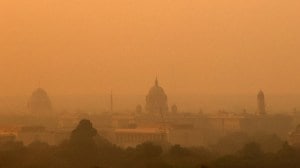The master painter
The Quran described Paradise in terms of green gardens and green silks and so it became a ‘Muslim’ colour. And, besides that, the ...

The Quran described Paradise in terms of green gardens and green silks and so it became a ‘Muslim’ colour. And, besides that, the Quran has something so beautiful in the Surah Al-Baqarah (The Cow), Quran 2:138: ‘Our sibgah (hue, meaning religion) is the sibgah of Allah (Islam). And who can give a better hue than Allah? It is He whom we worship’. It seems the root of the word sibgah is sibgath, an Arabic word meaning dye or colour, something that imparts colour to other things like cloth, paper or hair. Reading this recently, an old puzzle was finally solved. (We should have known these things as a matter of course, except that our cultural literacy is so fragmented). The puzzle was, why did Amir Khusro use the metaphor of dye so much? Mora rang hai, ae Ma, rang hai ri. (What colour I see, Mother, what colour!) Or, Mohe apna hi rang mein rang le (Dye me in your own colour). Or, Ab ke bahar, chunar meri rang de (This spring, dye my scarf for me). Or, Jo kuch maange, rang ki rangaai, mora joban girvi rakh le (Name your price, to colour me: take my youth in mortgage!). Or again, Sada rakhiyo lal gulal, Hajrat Khaja sangh khele dhamal (Let us keep the colourful spirit alive, let us play the Spring Song with our Guru).
Hindus too respond instinctively and with a whole heart to this spiritual meaning of ‘colour’. The Creator for us as for everyone else, is Light, and colour is the child of light. We realise intuitively that the Creator revels in colour, that the concept of Divinity is permeated with it. Many Hindus today are not taught how God begins to reveal His cosmic form to Arjuna at Kurukshetra. Sri bhagavan uvacha: pasya me partha rupani/sataso tha sahasrasah/ nana-vidhani divyani/nana varnakrtini ca. (The Blessed Lord said: My dear Arjuna, son of Prtha, behold now my opulence, hundreds of thousands of varied divine forms, in varied colours like the sea).
But while we may not know the Gita intimately, its colour has so permeated our culture that we pick up many messages just by being around. Going beyond saffron and green, there are two colours that Hindus and Muslims seem to share at a gut level: those divine blues. The purple-navy and the turquoise that we call Delhi Blue and Jaipur Blue respectively, but which actually come from Iznik in Turkey, via Samarkand. It’s scarcely surprising that they found a ready response in the land of the Blue Bhagwan!
Indeed, those sumptuous Islamic tile blues are deeply beloved across India. Not only do they adorn masjids, madrassas and mazaars, their colours have sanctity in the celestial blue of Mary’s mantle, the Buddhist chakra on our tricolour, the Nihang’s tunic and Shiva’s throat. Isn’t it curious that all our hearts are coloured with this love of blue?



- 01
- 02
- 03
- 04
- 05




























